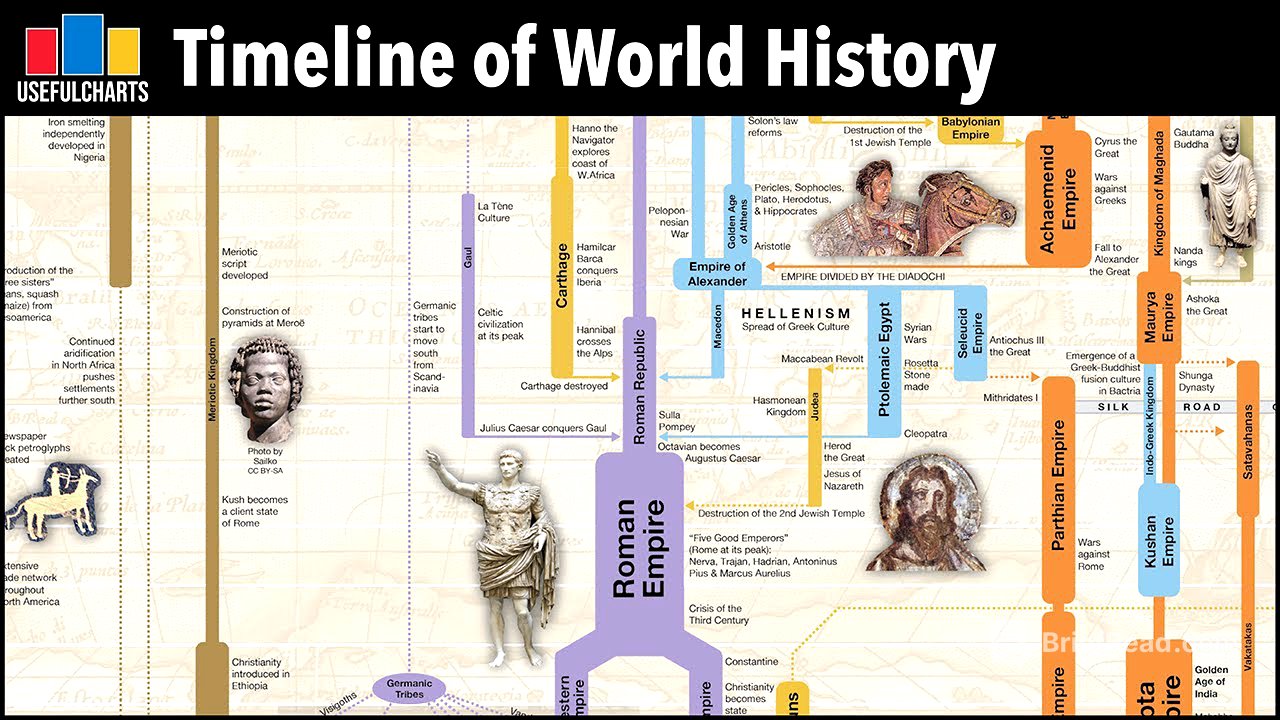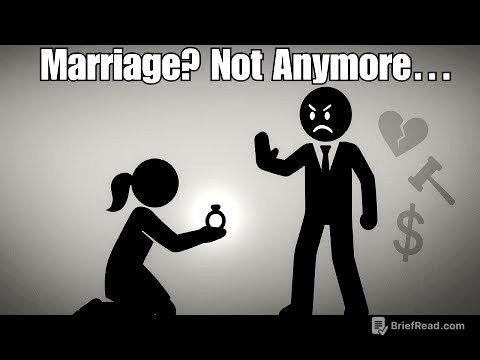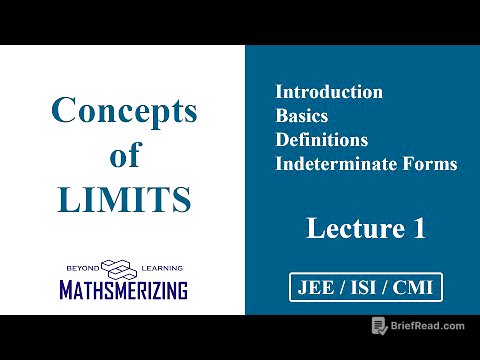TLDR;
Alright, so this video gives a big picture view of human history, breaking it down into different time periods like the Bronze Age, Iron Age, Middle Ages, and so on. It explains how these periods are defined and what major events mark the transitions between them. Key takeaways include:
- History is divided based on major shifts like the development of writing, the use of bronze and iron, and significant cultural and political changes.
- Climate events, migrations, and pandemics often play a big role in these transitions.
- The video uses a timeline chart to visually represent the relative importance of different cultures and civilizations throughout history.
Intro to the Timeline [0:00]
The video introduces a timeline chart that shows human history. Time flows downwards, with each white line marking 100 years. The chart is designed to allow for accurate comparisons across different time periods. Horizontally, the chart is divided into regions: the Americas, Africa, Europe, Asia, and the Pacific Islands. The width of each line represents the relative importance of a culture or civilization in its time and region.
Understanding AD, BC, CE, and BCE [1:46]
The video explains the terms AD (Anno Domini) and BC (Before Christ), which are used to mark years in relation to the birth of Jesus. It also mentions that many historians now use CE (Common Era) and BCE (Before the Common Era) as more neutral alternatives. The video clarifies that there is no year zero, so 1 BC is immediately followed by 1 AD.
Defining the Starting Point of History [3:02]
The video sets the starting point of history at 3300 BCE, which is around when writing first appeared. The idea is that without written records, we're in the realm of prehistory. Prehistory goes way back, like 200,000 years for Homo sapiens and 4.5 billion years for Earth, but the chart focuses on the period after the invention of writing.
The Early Bronze Age [4:17]
The Early Bronze Age is when humans started using bronze and developing writing, mainly in Egypt, Sumer (modern Iraq), and the Indus Valley (modern Pakistan). While Egyptian and Sumerian records can be read, the Indus Valley script is still a mystery. These civilizations traded with each other and grew in technology. Sumerians invented the wheel, plow, and sail, and developed astronomy and mathematics. In Egypt, the Great Pyramids of Giza were built. The Norte Chico civilization in Peru also had large cities but no writing or pottery.
The Bronze Age [5:57]
The transition from the Early Bronze Age to the Bronze Age proper is marked by the 4.2 kiloyear event, a period of extreme drought about 4,200 years ago. This led to the decline of the Egyptian Old Kingdom, the Akkadian Empire, and the Indus Valley Civilization. New cultures emerged, like the Egyptian Middle and New Kingdoms and the Babylonian civilization. The Indus Valley cities disappeared, and the Indo-Aryans arrived. Civilizations also arose in China, sub-Saharan Africa, and North America (the Poverty Point culture). In Europe, the Minoans on Crete formed the first civilization, but a volcanic eruption led to their downfall and the rise of the Mycenaean Greeks.
The Bronze Age Collapse and the Iron Age [7:47]
Around 1200 BCE, the Bronze Age collapsed, causing major civilizations in Greece, Anatolia, and Egypt to disappear. This was followed by the Greek Dark Ages, a period with little historical record. Many famous legendary tales, like those in the Torah, the Iliad, and the Mahabharata, are said to have taken place during this time. The Bronze Age collapse also coincided with the first use of iron in the Middle East, marking the start of the Iron Age.
Classical Antiquity [8:51]
After 600 BCE, we get more detailed historical records, thanks to writings like those of Herodotus, the "father of History." Classical Antiquity is when the Greeks and Romans laid the foundations for Western Civilization, building on earlier Bronze Age knowledge. There was also a lot happening elsewhere, like the Olmec influencing the Maya in Mesoamerica, extensive trade networks in North America, the Kingdom of Aksum in Ethiopia, the Persian, Mauryan, and Gupta empires, and the first Imperial Dynasty in China. The Silk Road connected Eurasia. This period also saw the development of Greek philosophy, the Bible, Hindu and Buddhist scriptures, the writings of Confucius, and the first experiments with democracy and scientific thinking.
The Middle Ages [11:40]
Around 500 CE, the Western Roman Empire fell, marking the end of Classical Antiquity and the start of the Middle Ages. The term "Dark Ages" shouldn't really be used for this period because it only applies to Western Europe. The Middle East and China were actually having golden ages. Large-scale migrations, possibly due to climate change, led to a domino effect. The Huns pushed Germanic tribes into conflict with Rome, leading to the fall of the Western Empire. Extreme weather events and the plague of Justinian also caused problems. Islam rose in the Middle East, while Christianity expanded in Europe. Barbarian kingdoms evolved into major powers like England, France, and the Holy Roman Empire. There were also major empires in West Africa, like the Mali Empire with Mansa Musa, and the city of Great Zimbabwe in southern Africa. In the Americas, there was Cahokia in North America, the Pueblo cities in New Mexico, the Aztecs in Mesoamerica, and the Incas in South America. The Mongol Empire, the largest land empire of all time, also emerged during this period.
The Modern Age [15:27]
The Modern Age, the period we live in today, may have started with the Black Death, which killed up to 50% of the population in many cities. This may have sparked the Renaissance. The Eastern Roman Empire fell to the Ottoman Turks, and there was a renewed interest in classical art and philosophy in Italy. Europeans started colonizing the Americas, and major advances were made in science, leading to the Industrial Revolution and the technological revolution we're still experiencing.
Similarities in Transitions [16:25]
The video concludes by noting that the transitions between time periods often involve a combination of climate events, mass migrations, and pandemics. Since we're currently dealing with these things in 2020, it raises the question of whether we're on the verge of entering a new period in human history.









